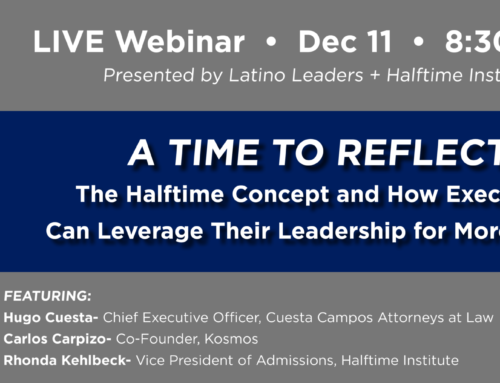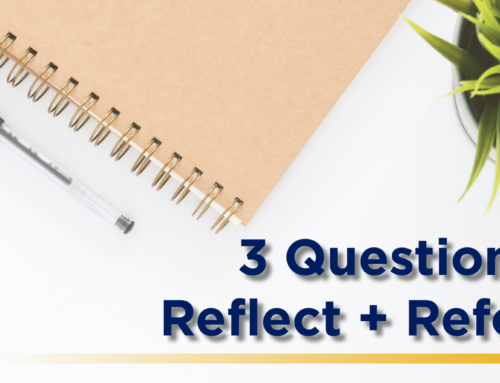Do you have lots of acquaintances, some buddies, but few (if any) deep, lasting friendships?
You’re not alone. For one, I can relate. And I see it often in the hard-driving achievers that I coach. Many leaders reach midlife and discover that intimacy has been squeezed out of their marriage, family and friendships.
Yet I’ve found that a reflective leader will realize that this is a key measure of success that needs attention for a fulfilling and meaningful second half. Out of intimacy comes trust, understanding, romance. What is more – deep, intimate relationships pave the road to lasting impact in this world.
So, how did we get here? Intimacy is a skill we are seldom taught or compensated for in our first half careers. For many successful people, real connections have been the casualty of stress, business travel, and perhaps self-absorption.
Halftime is a season of life when you can change that.
Along this journey, you will likely discover that midlife renewal is less about doing and more about being. Less of your identity will be wrapped up in your career or accomplishments. More joy will come from relationships – beginning with your relationship with God, your spouse, your kids and some deepening friendships.
God has always existed in deep, intimate community between the Father, Son, and Holy Spirit. His intent for us is to live in intimacy with him and with each other.
Some of us have been so caught up in the pursuit of our goals that we have had little time to understand the value of intimacy or to learn to dismantle the barriers that stand in its way. Our culture sometimes confuses intimacy with sex. Sex can be part of intimacy, but intimacy is much more than sex.
Most men arrive at midlife with few, if any, close friendships. Women tend to have more. Over the past twenty years I have explored why this is by asking each new person that I coach to tell me about their friendships. As I listen, I find that most men have lots of acquaintances, but few close friends with whom they share their deepest thoughts and feelings. When they let off the gas in their careers, they begin to realize relationships are not optional; they are essential.
A new focus is given to the journey from isolation to intimacy. Yet, sometimes it’s easier to see what is missing than to know what to do about it.
In my own journey, I remember observing deep relationships in others’ lives and even in movies but didn’t know how to begin to move in that direction. In addition, I was somewhat afraid of the awkwardness it might entail.
When I reached into my “toolbox for life,” I found some big wrenches, hammers and screw drivers that made me effective in business but very few tools that might help me in this new area. I needed some new tools, a few simple instructions, and lots of practice. I wish someone had taught me to use the following structure of who, when, what and how steps to developing intimacy. You can adapt these to where you are in this skill development process:
- Who – Who do you want to develop a deep, meaningful relationship with? Sometimes we don’t get down to the business of loving a few people extravagantly simply because we don’t decide who those people are. Ultimately, it always boils down to names. We don’t have time or energy to love everyone deeply or to pursue intimacy with lots of people, but we can with a few. In addition to your immediate family, who are the two or three people you would most like to connect with?
- When – When could you be with or connect with the people on your list? Relationships take time. If you’re serious, these people will begin to show up regularly on your calendar. A date night with your spouse, weekly Skype call with your adult kids, time to work out at the gym with your closest friend, or an annual weekend with your siblings.
- What – What do your friends and family want to know about your inside world? Intimacy is about knowing what’s going on inside each other’s hearts and minds. You can spell intimacy as “into-me-see”. It’s about vulnerability, exposure to each other’s deepest feelings, dreams and challenges, met with loving acceptance. Your next simple step is to ask what your family/friends want to know about your inside world that you don’t normally share.
- How – How can you communicate these inner thoughts and feelings in a way that is meaningful to them and less awkward for you? Often, saying what is in your heart is the most difficult. So, instead, find the easiest ways you can communicate your inner feelings with those you love. Here are a few I’ve found helpful: Cards, emails, text, a voice message, a picture or painting that conveys the message, gifts with special meaning, a toast or speech at special gatherings, face to face (this is often the most difficult).
One last thing – be patient.
You really can’t rush the process of building deep connections. It goes at the pace of trust, and each person will react differently to your desire for a deeper relationship. I was so fortunate that three of my closest friends were already good at this and, for whatever reason, wanted a deeper friendship. Be patient and before you know it, you will be in the midst of meaningful and fulfilling relationships.
Cheers,
Lloyd
This post gives a taste of Lloyd’s most recent e-book, “Finally Connected: Deep, Meaningful Relationships in Your Second Half”. For the full details visit the dedicated page and download the eBook.






